The-Imperial-Examination-System-中国科举制度-中英文双语
- 格式:ppt
- 大小:1.18 MB
- 文档页数:12
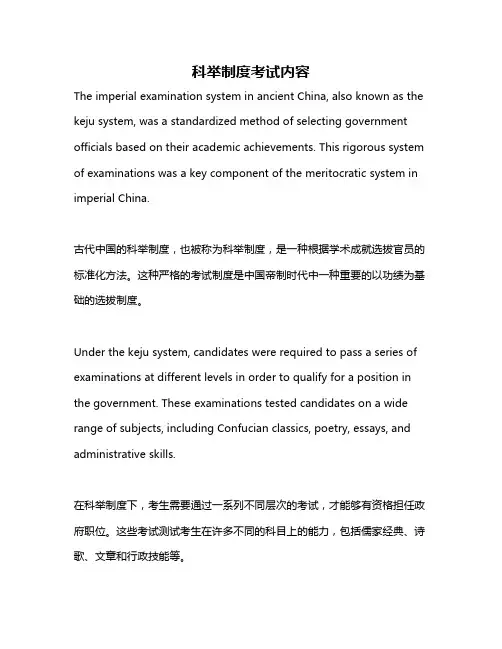
科举制度考试内容The imperial examination system in ancient China, also known as the keju system, was a standardized method of selecting government officials based on their academic achievements. This rigorous system of examinations was a key component of the meritocratic system in imperial China.古代中国的科举制度,也被称为科举制度,是一种根据学术成就选拔官员的标准化方法。
这种严格的考试制度是中国帝制时代中一种重要的以功绩为基础的选拔制度。
Under the keju system, candidates were required to pass a series of examinations at different levels in order to qualify for a position in the government. These examinations tested candidates on a wide range of subjects, including Confucian classics, poetry, essays, and administrative skills.在科举制度下,考生需要通过一系列不同层次的考试,才能够有资格担任政府职位。
这些考试测试考生在许多不同的科目上的能力,包括儒家经典、诗歌、文章和行政技能等。
One of the key features of the keju system was its focus on meritocracy, where individuals were selected for government positions based on their ability and talent rather than their family background or social status. This allowed individuals from all walks of life to have the opportunity to advance in society based on their intellectual capabilities.科举制度的一个关键特点是它着重于以功绩为基础的原则,即个人能力和才华胜任政府职位的被选拔标准,而不是他们的家庭背景或社会地位。
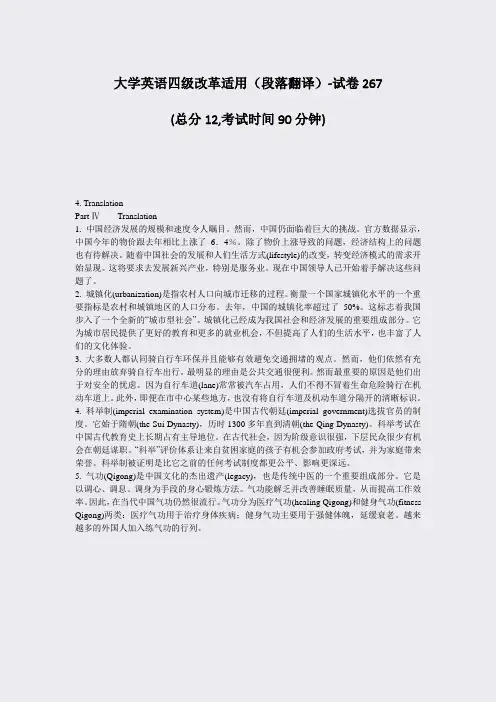
大学英语四级改革适用(段落翻译)-试卷267(总分12,考试时间90分钟)4. TranslationPart ⅣTranslation1. 中国经济发展的规模和速度令人瞩目。
然而,中国仍面临着巨大的挑战。
官方数据显示,中国今年的物价跟去年相比上涨了6.4%。
除了物价上涨导致的问题,经济结构上的问题也有待解决。
随着中国社会的发展和人们生活方式(lifestyle)的改变,转变经济模式的需求开始显现。
这将要求去发展新兴产业,特别是服务业。
现在中国领导人已开始着手解决这些问题了。
2. 城镇化(urbanization)是指农村人口向城市迁移的过程。
衡量一个国家城镇化水平的一个重要指标是农村和城镇地区的人口分布。
去年,中国的城镇化率超过了50%。
这标志着我国步入了一个全新的“城市型社会”。
城镇化已经成为我国社会和经济发展的重要组成部分。
它为城市居民提供了更好的教育和更多的就业机会,不但提高了人们的生活水平,也丰富了人们的文化体验。
3. 大多数人都认同骑自行车环保并且能够有效避免交通拥堵的观点。
然而,他们依然有充分的理由放弃骑自行车出行。
最明显的理由是公共交通很便利。
然而最重要的原因是他们出于对安全的忧虑。
因为自行车道(lane)常常被汽车占用,人们不得不冒着生命危险骑行在机动车道上。
此外,即便在市中心某些地方,也没有将自行车道及机动车道分隔开的清晰标识。
4. 科举制(imperial examination system)是中国古代朝廷(imperial government)选拔官员的制度。
它始于隋朝(the Sui Dynasty),历时1300多年直到清朝(the Qing Dynasty)。
科举考试在中国古代教育史上长期占有主导地位。
在古代社会,因为阶级意识很强,下层民众很少有机会在朝廷谋职。
“科举”评价体系让来自贫困家庭的孩子有机会参加政府考试,并为家庭带来荣誉。
科举制被证明是比它之前的任何考试制度都更公平、影响更深远。
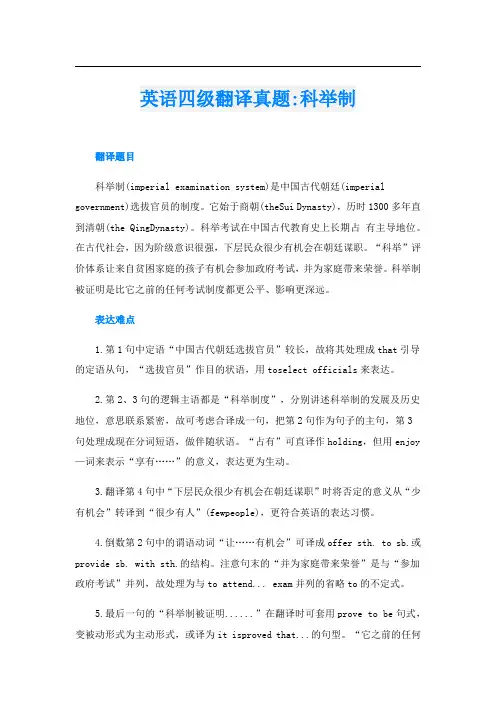
英语四级翻译真题:科举制翻译题目科举制(imperial examination system)是中国古代朝廷(imperial government)选拔官员的制度。
它始于商朝(theSui Dynasty),历时1300多年直到清朝(the QingDynasty)。
科举考试在中国古代教育史上长期占有主导地位。
在古代社会,因为阶级意识很强,下层民众很少有机会在朝廷谋职。
“科举”评价体系让来自贫困家庭的孩子有机会参加政府考试,并为家庭带来荣誉。
科举制被证明是比它之前的任何考试制度都更公平、影响更深远。
表达难点1.第1句中定语“中国古代朝廷选拔官员”较长,故将其处理成that引导的定语从句,“选拔官员”作目的状语,用toselect officials来表达。
2.第2、3句的逻辑主语都是“科举制度”,分别讲述科举制的发展及历史地位,意思联系紧密,故可考虑合译成一句,把第2句作为句子的主句,第3句处理成现在分词短语,做伴随状语。
“占有”可直译作holding,但用enjoy —词来表示“享有……”的意义,表达更为生动。
3.翻译第4句中“下层民众很少有机会在朝廷谋职”时将否定的意义从“少有机会”转译到“很少有人”(fewpeople),更符合英语的表达习惯。
4.倒数第2句中的谓语动词“让……有机会”可译成offer sth. to sb.或provide sb. with sth.的结构。
注意句末的“并为家庭带来荣誉”是与“参加政府考试”并列,故处理为与to attend... exam并列的省略to的不定式。
5.最后一句的“科举制被证明......”在翻译时可套用prove to be句式,变被动形式为主动形式,或译为it isproved that...的句型。
“它之前的任何考试制度”可直译为any other previous examination system或将“它之前的”处理成“考试制度”的后置定语existing before it。
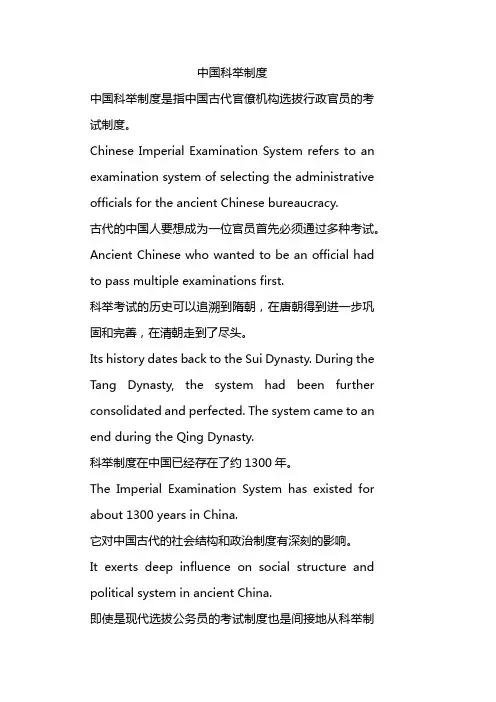
中国科举制度中国科举制度是指中国古代官僚机构选拔行政官员的考试制度。
Chinese Imperial Examination System refers to an examination system of selecting the administrative officials for the ancient Chinese bureaucracy.古代的中国人要想成为一位官员首先必须通过多种考试。
Ancient Chinese who wanted to be an official had to pass multiple examinations first.科举考试的历史可以追溯到隋朝,在唐朝得到进一步巩固和完善,在清朝走到了尽头。
Its history dates back to the Sui Dynasty. During the Tang Dynasty, the system had been further consolidated and perfected. The system came to an end during the Qing Dynasty.科举制度在中国已经存在了约1300年。
The Imperial Examination System has existed for about 1300 years in China.它对中国古代的社会结构和政治制度有深刻的影响。
It exerts deep influence on social structure and political system in ancient China.即使是现代选拔公务员的考试制度也是间接地从科举制度演变而来的。
Even the modern examination system for selecting civil service staff also indirectly evolved from it.。

Unit 1不丹1999才引进电视,是世界上最后一个开放电视与网络的国家,手机和互联网的普及率( penetra on )分别仅为30%和5%,几乎与现代化世界格格不入。
大多数人没有手机,也不上互联网,因此不太可能成为低头族( phubber )或者晚睡族(nightpersons)。
在别的国家拼命发展经济、不惜代价提升GDP 时,不丹追求的是国民幸福总值( Gross Na onal Happiness)。
他们乐于吸取现代技术的益处,但要按照自己的步伐,但要按照自己的步伐,根据自己的需要,根据自己的需要,根据自己的需要,在自已觉得合适的时机去进行。
在自已觉得合适的时机去进行。
在自已觉得合适的时机去进行。
他们同他们同样渴望经济繁荣,但不会以牺牲他们所珍视的传统和文化为代价。
样渴望经济繁荣,但不会以牺牲他们所珍视的传统和文化为代价。
Bhutan did not introduce TV until 1999, and is the last country that is open to TV and the Internet. Its mobile phone and Internet penetrations are as low as 30% and 5% respectively, almost out of tune with the modernized world. Now that the majority of its people have no mobile phones and no access to the Internet, they have little odds of being phubbers or night persons. While the other countries are striving desperately to develop economy and boost GDP at all costs, what Bhutan pursues is GNH (Gross National Happiness). They are willing to take advantage of modern technology, but would do it at their own pace, according to their own needs and at their own proper time. Although likewise thirsting for economic prosperity, Bhutan refuses to realize it at the price of their cherished tradition and culture.Unit 2中国的科举制度( the imperial examination system in China) 最早始于隋朝,历经1300多年。
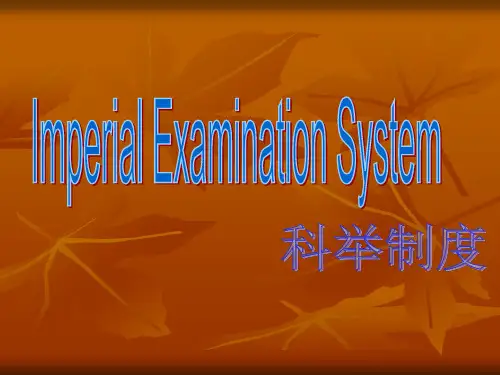
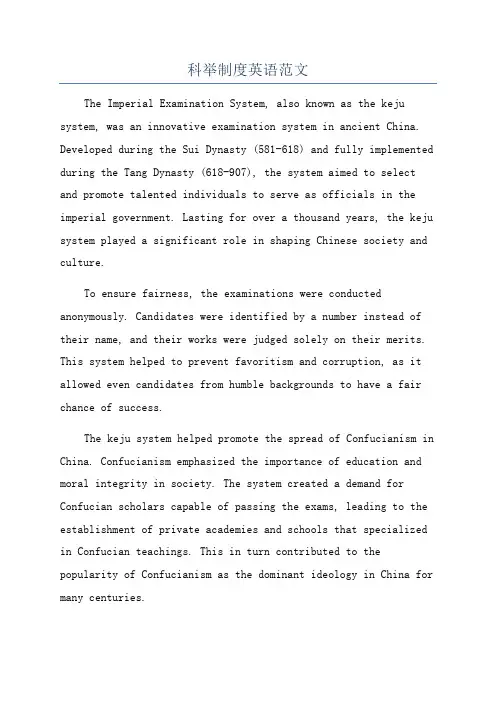
科举制度英语范文The Imperial Examination System, also known as the keju system, was an innovative examination system in ancient China. Developed during the Sui Dynasty (581-618) and fully implemented during the Tang Dynasty (618-907), the system aimed to select and promote talented individuals to serve as officials in the imperial government. Lasting for over a thousand years, the keju system played a significant role in shaping Chinese society and culture.To ensure fairness, the examinations were conducted anonymously. Candidates were identified by a number instead of their name, and their works were judged solely on their merits. This system helped to prevent favoritism and corruption, as it allowed even candidates from humble backgrounds to have a fair chance of success.The keju system helped promote the spread of Confucianism in China. Confucianism emphasized the importance of education and moral integrity in society. The system created a demand for Confucian scholars capable of passing the exams, leading to the establishment of private academies and schools that specialized in Confucian teachings. This in turn contributed to the popularity of Confucianism as the dominant ideology in China for many centuries.。
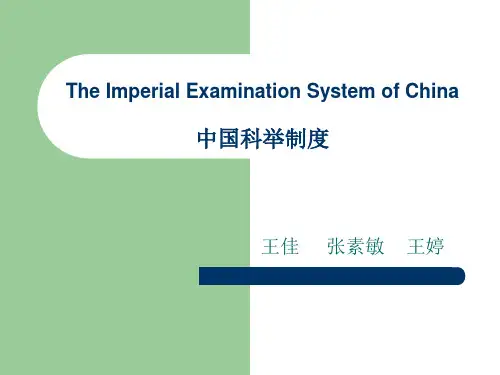
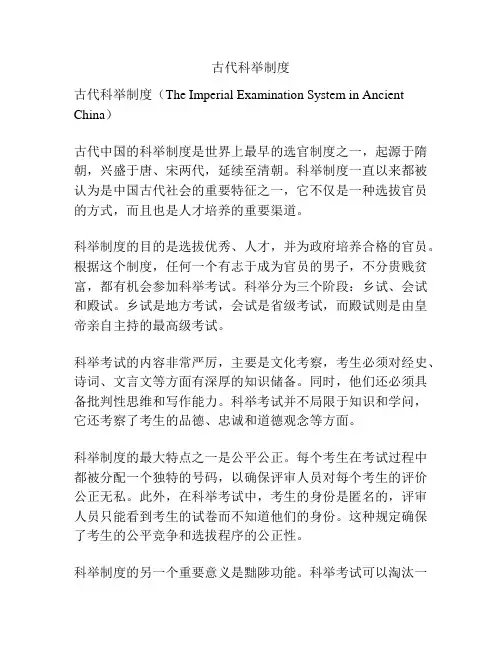
古代科举制度古代科举制度(The Imperial Examination System in Ancient China)古代中国的科举制度是世界上最早的选官制度之一,起源于隋朝,兴盛于唐、宋两代,延续至清朝。
科举制度一直以来都被认为是中国古代社会的重要特征之一,它不仅是一种选拔官员的方式,而且也是人才培养的重要渠道。
科举制度的目的是选拔优秀、人才,并为政府培养合格的官员。
根据这个制度,任何一个有志于成为官员的男子,不分贵贱贫富,都有机会参加科举考试。
科举分为三个阶段:乡试、会试和殿试。
乡试是地方考试,会试是省级考试,而殿试则是由皇帝亲自主持的最高级考试。
科举考试的内容非常严厉,主要是文化考察,考生必须对经史、诗词、文言文等方面有深厚的知识储备。
同时,他们还必须具备批判性思维和写作能力。
科举考试并不局限于知识和学问,它还考察了考生的品德、忠诚和道德观念等方面。
科举制度的最大特点之一是公平公正。
每个考生在考试过程中都被分配一个独特的号码,以确保评审人员对每个考生的评价公正无私。
此外,在科举考试中,考生的身份是匿名的,评审人员只能看到考生的试卷而不知道他们的身份。
这种规定确保了考生的公平竞争和选拔程序的公正性。
科举制度的另一个重要意义是黜陟功能。
科举考试可以淘汰一些不称职或无能的考生,同时也可以提拔一些才华横溢、有能力的考生进入政府机构。
通过科举考试选拔的官员被认为是最合适的人选,由于他们具备了合格的知识和道德观念,所以他们在政府工作岗位上表现出色并能够为国家做出更大的贡献。
科举制度也有一些问题和争议。
一方面,科举制度过于注重书本知识,对于实际能力缺乏考察,这可能导致一些选出来的官员在实践中不够出色。
另一方面,科举制度也对农民和贫穷家庭的孩子来说不太公平。
由于他们没有机会接受高等教育,他们的学问储备和机会被剥夺。
因此,科举制度也受到了一些批评。
尽管存在一些争议,科举制度在中国的政府选官制度中起到了重要作用。
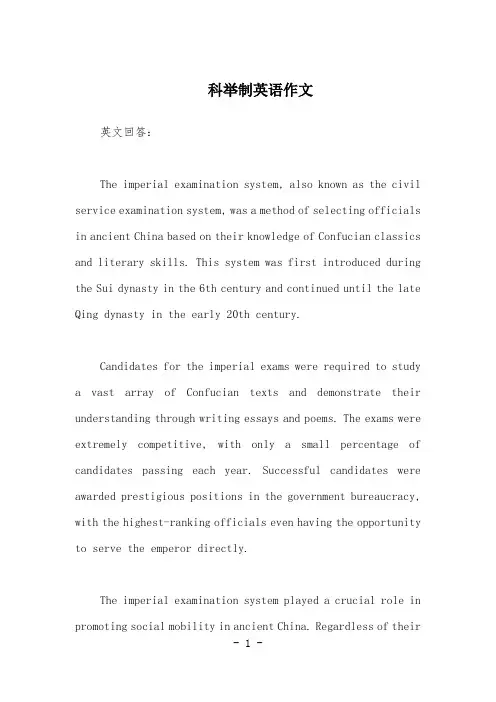
科举制英语作文英文回答:The imperial examination system, also known as the civil service examination system, was a method of selecting officials in ancient China based on their knowledge of Confucian classics and literary skills. This system was first introduced during the Sui dynasty in the 6th century and continued until the late Qing dynasty in the early 20th century.Candidates for the imperial exams were required to study a vast array of Confucian texts and demonstrate their understanding through writing essays and poems. The exams were extremely competitive, with only a small percentage of candidates passing each year. Successful candidates were awarded prestigious positions in the government bureaucracy, with the highest-ranking officials even having the opportunity to serve the emperor directly.The imperial examination system played a crucial role in promoting social mobility in ancient China. Regardless of theirbackground or social status, anyone who passed the exams could potentially rise to the highest levels of government. This meritocratic approach to governance was seen as a way to ensure that officials were chosen based on their abilities rather than their family connections.中文回答:科举制度是古代中国选拔官员的一种方法,根据他们对儒家经典和文学技能的了解来选拔。
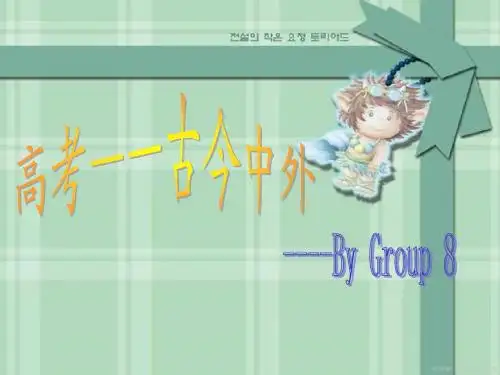
介绍科举制的英语作文Title: The Imperial Examination System: A Pivotal Milestone in Chinese History.The Imperial Examination System, often referred to asthe Keju in Chinese, was a pivotal institution that shaped the educational and bureaucratic landscape of China forover a thousand years. Its inception marked a significant departure from the patronage-based recruitment of officials, introducing a meritocratic principle that emphasized intellectual ability and expertise over social status or wealth. This essay delves into the history, structure, and impact of this remarkable system.Origins and Evolution.The Imperial Examination System originated in the Sui Dynasty (581-618 AD) as a means to centralize power and standardize the recruitment of bureaucrats. Prior to this, official positions were often awarded based on familybackground or political connections, leading to a disproportionate distribution of power and resources. The Sui Emperor Wendi recognized the need for a more equitable and objective system and thus instituted the Keju.Over the centuries, the system underwent numerous refinements and expansions, reaching its peak during the Ming and Qing Dynasties. These refinements included the addition of more subjects, the establishment of a three-tiered examination structure, and the gradualstandardization of the questions and grading criteria.Structure and Process.The Imperial Examinations were conducted in three tiers: the County-level, Provincial-level, and the Imperial-level. Candidates first appeared for the County-level exam, which tested basic literacy and knowledge of Confucian classics. Successful candidates then moved on to the Provincial-level exam, which was more rigorous and competitive. Finally, the most outstanding candidates were invited to the capital for the Imperial-level exam, which was the most prestigious andcompetitive stage.The content of the exams was primarily focused on Confucian classics, history, poetry, and essay writing. The questions were designed to assess the candidate's knowledge, analytical ability, and writing skills. The gradingcriteria were strict, and only the most outstanding candidates were awarded positions in the bureaucracy.Impact and Legacy.The Imperial Examination System had profound impacts on Chinese society and culture. It created a class of scholars who were highly respected for their intellectual abilities and expertise. It also provided a pathway for social mobility, allowing talented individuals from humble backgrounds to rise to positions of power and influence.Moreover, the system fostered a culture of learning and literacy that persisted for centuries. It encouraged the study of Confucian classics, which in turn influenced the development of Chinese philosophy, literature, and art. Theexams also played a significant role in the dissemination of knowledge and ideas, promoting intellectual exchange and 辩论 among scholars.However, the system also had its limitations. It was highly competitive and stressful, leading to intense study and preparation regimens. It also favored candidates who were well-versed in Confucian classics over those with practical skills or innovative ideas.Conclusion.The Imperial Examination System was a remarkable institution that shaped the course of Chinese history for over a thousand years. It introduced a meritocratic principle to official recruitment, fostering a culture of learning and literacy that had profound impacts on Chinese society and culture. While it had its limitations, the system remains a significant milestone in the history of education and bureaucracy. Its influence can still be seen in modern China, where the value of education and intellectual ability remains highly valued.。
科举制英语作文The Imperial Examination System: A Glance into China's Educational TraditionIn the vast landscape of Chinese history, one institution stands out for its longevity, influence, and distinctive approach to selecting talent: the Imperial Examination System, or keju (科举). Spanning over a millennium, from its inception in the Sui dynasty to its abolition in the early 20th century, this system shaped the intellectual and bureaucratic elite of imperial China. Delving into its origins, mechanics, and legacy offers valuable insights into China's educational tradition.Rooted in the Confucian philosophy of meritocracy, the Imperial Examination System aimed to identify and nurture individuals with exemplary moral character, intellectual prowess, and administrative aptitude to serve the state. Its origins can be traced back to the Sui dynasty (581-618 AD), but it reached its zenith during the Tang (618-907 AD) and Song (960-1279 AD) dynasties. Under this system, candidates from diverse social backgrounds could participate, theoretically offering equal opportunities for advancement.The examination process was rigorous and multifaceted, consisting of several tiers: the county-level exam (xianju), the provincial-level exam (shengju), and the highest level, the metropolitan exam (huishi). Each exam tested candidates on various subjects, including Confucian classics, poetry, essays, and sometimes administrative skills. Success in these exams opened doors to prestigious government positions, offering wealth, power, and social status.Despite its meritocratic ideals, the Imperial Examination System faced criticisms and challenges throughout its history. Critics argued that it favored rote memorization over critical thinking and innovation, leading to a stagnant intellectual environment. Additionally, the system perpetuated social inequality by primarily benefiting the wealthy and well-connected, who could afford education and resources to prepare for the exams.Nevertheless, the Imperial Examination System left an indelible mark on Chinese society and culture. It fostered a reverence for learning and education, elevating scholars to the highest ranks of society. The emphasis on Confucian values of filial piety, loyalty, and moral integrity shaped the ethos of Chinese governance for centuries. Moreover, thesystem contributed to the standardization of the Chinese written language and the dissemination of classical literature and philosophy.With the decline of the Qing dynasty and the advent of modernization in the late 19th century, the Imperial Examination System came under increasing scrutiny. Critics denounced it as antiquated and incompatible with the needs of a rapidly changing world. In 1905, the Qing government announced its abolition, marking the end of an era and the beginning of a new chapter in China's educational history.In retrospect, the Imperial Examination System remains a testament to China's enduring commitment to education and governance. Its strengths and shortcomings offer valuable lessons for contemporary educational systems worldwide. While its rigid structure and elitist tendencies may be criticized, its emphasis on meritocracy and intellectual cultivation resonates with enduring values of fairness and excellence.In conclusion, the Imperial Examination System stands as a symbol of China's rich educational heritage. Its influence transcends time and continues to shape perceptions of education, governance, and meritocracy in contemporary China and beyond. As we reflect on its legacy, we are reminded of the enduring quest for knowledge, virtue, and social progress that defines the essence of human civilization.。
隋唐科举考试流程The imperial examination system, also known as the Keju exam, wasa process in ancient China for selecting candidates for the state bureaucracy. It was established during the Sui dynasty and continued through the Tang dynasty. This examination system was a major mechanism for social mobility in Imperial China, as it allowed people from all social classes to attain prestigious positions in the government. 隋唐科举考试是古代中国选拔官员的一种选拔制度,它始于隋朝并延续至唐朝。
科举考试是古代中国社会流动性的主要机制,它允许社会各阶层的人们在政府中获得重要职位。
The examination process was incredibly rigorous and required yearsof preparation. It was divided into three levels: the local level, the regional level, and the imperial level. Candidates would first takelocal exams, and those who passed would then move on to the regional exams. Finally, successful candidates from the regional exams would have the opportunity to take the imperial exam held in the capital. 这一考试流程非常严格,需要数年的准备。
大学英语六级翻译-5(总分100,考试时间90分钟)Translation1. 中国科举制度(Chinese Imperial Examination System)是指中国古代官僚机构选拔行政官员的考试制度。
古代的中国人要想成为一位官员首先必须通过多种考试。
科举考试的历史可以追溯到隋朝,在唐朝得到进一步巩固和完善,在清朝走到了尽头。
科举制度在中国已经存在了约1,300年。
它对中国古代的社会结构和政治体制有深刻的影响。
即使是现代选拔公务员的考试制度也是间接地从科举制度演变而来的。
2. 唐代文化是中国文化的一个高峰。
尤其是古典诗歌到唐代发展到全盛时期。
在唐代300余年的历史中,产生的流传于后世的诗歌就有48,900多首。
如此丰富的作品也使2,300多位诗人在历史上留下了他们的名字。
唐诗在创作方法上,现实主义与浪漫主义并举。
唐代最著名的诗人是李白和杜甫,他们都是具有世界声誉的诗人,后人将他们合称为“李杜”。
3. 江苏菜,又叫淮扬菜,流行于长江下流区域,以水产作为主要原料,注重原料的鲜味。
其雕刻技术十分珍贵,其中瓜雕(melon carving)尤其著名。
烹饪技术包括炖、烤、焙、煨(simmering)等。
江苏菜的特色是淡、鲜、甜、雅。
江苏菜系以其精选的原料,精细的准备,不辣不温的口感而出名。
因为江苏气候变化很大,江苏菜系在一年之中也有变化。
味道强而不重,淡而不温。
4. 根据中国的阴阳五行学说,世界上所有的事物都是由金、木、水、火、土五种元素构成,这五种元素相生相克,白色代表金,绿色代表木,黑色代表水,红色代表火,黄色则代表土。
中国社会发展到汉代以后,黄色开始被人所接受,并认为是最尊贵的颜色。
唐代以后,服饰制度规定只准皇室穿黄色的服饰,其他人一概不允许。
5. 年画(New Year Painting)是中国画的一种,始于古代的门神画(door god painting),在清朝光绪年间正式被称为“年画”。